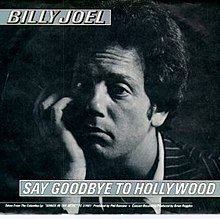Loading AI tools
Billy Joel song From Wikipedia, the free encyclopedia
"Say Goodbye to Hollywood" is a song written and performed by Billy Joel, first released in 1976 on his album Turnstiles as its opening track. It was originally released in the United States as the B-side to "I've Loved These Days" before being released as A-side in various countries like the UK, Germany and Australia in November 1976, with "Stop in Nevada" as the B-side.[2] However, the song achieved greater recognition in 1981 when a live version from Songs in the Attic was released as a US single, with the live version of "Summer, Highland Falls" as a B-side. Joel wrote the song after moving back to New York City in 1975; he had previously relocated to Los Angeles in 1972 in an attempt to get out of an onerous record deal. The man who represents this song on the Turnstiles album is the man wearing sunglasses and holding a suitcase.
| "Say Goodbye to Hollywood" | ||||
|---|---|---|---|---|
 Cover art for the 1976 single | ||||
| Single by Billy Joel | ||||
| from the album Turnstiles | ||||
| B-side | "Stop In Nevada" | |||
| Released | November 1976 (UK)[1] | |||
| Recorded | 1976 at Ultrasonic Recording Studios, Hempstead, NY | |||
| Genre | Pop rock | |||
| Length | 4:38 (Album version) 3:53 (Single version) | |||
| Label | Columbia | |||
| Songwriter(s) | Billy Joel | |||
| Producer(s) | Billy Joel | |||
| Billy Joel singles chronology | ||||
| ||||
| "Say Goodbye to Hollywood" | ||||
|---|---|---|---|---|
 Cover art for the 1981 single | ||||
| Single by Billy Joel | ||||
| from the album Songs in the Attic | ||||
| B-side | "Summer, Highland Falls" | |||
| Released | 1981 | |||
| Recorded | June 1980 at Milwaukee Arena, Milwaukee, WI | |||
| Genre | Pop rock | |||
| Length | 4:25 | |||
| Label | Columbia | |||
| Songwriter(s) | Billy Joel | |||
| Producer(s) | Phil Ramone | |||
| Billy Joel singles chronology | ||||
| ||||
Joel has stated in his university lectures that he wrote the song with Ronnie Spector and The Ronettes song "Be My Baby" in mind.[2][3] Indeed, Joel notes that the two songs share a very similar beat, recycling the iconic drum intro of "Be My Baby".[4] The song's production was also specifically modeled on the "Wall of Sound" production method of her ex-husband Phil Spector, who produced "Be My Baby" in that manner. The song utilized a backing band throughout the track, with new instrumental layers appearing throughout the song, such as backup singers in the refrain and strings starting from the second verse. However, whether this effect had been achieved was in dispute, with biographer Mark Bego claiming it was successful in this regard, while music critic Stephen Holden disagreed.[5] Billboard said that it "has the intensity and flair of Phil Spector's early '60s classics."[6] Record World said that the live version "sounds better than the original," with "a perfect blend of concert spontaneity and studio clarity."[7]
| Chart (1976) | Peak position |
|---|---|
| Australia (Kent Music Report)[9] | 45 |
| Chart (1981) | Peak position |
| Canadian Singles Chart[10] | 27 |
| U.S. Billboard Hot 100[11] | 17 |
| U.S. Billboard Adult Contemporary[12] | 35 |
Seamless Wikipedia browsing. On steroids.
Every time you click a link to Wikipedia, Wiktionary or Wikiquote in your browser's search results, it will show the modern Wikiwand interface.
Wikiwand extension is a five stars, simple, with minimum permission required to keep your browsing private, safe and transparent.